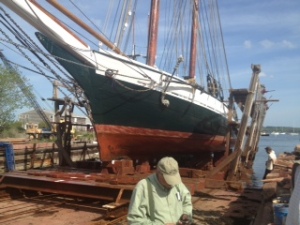Fish Out of Water (Part 2) — My FIRST EVER!!! Video included
Well folks, the Mercantile crew is getting ready to go back out on the water. Tonight we load 12 passengers and we sail from Camden Harbor around 10am tomorrow morning. Mid week, 2 passengers will disembark and we’ll add 16 new passengers (or thereabouts). I’m excited to be going back out and to re-kindle the fire in the morning.
But, for now, I am posting this video — really my first ever attempt at video — of the Grace Bailey’s trip to the ship yard a few weeks ago. It’s not that exciting, but it’s a little taste of what it’s like to be on the deck of the boat. We are not under sail in the video, but instead are being pushed by the yawl boat from Camden to Rockland.
Check it out here: https://www.youtube.com/watch?v=vZRkV1Qno_M
After getting the Bailey up on blocks and hauled out of the water, the Captain made an assessment of the hull, which was then scraped by hand and repainted over the course of our 3 days in the yard. The scraping was dirty work, mostly done by Jerika, Becky and Jonathan. I spent most of the time in the ship yard touching up paint on the deck and painting the water line (enjoying the privileges of being the ship’s cook) — cutting in with a hand held paint brush the transition from green to red that is visible just above the water line when the boat is in the water.
Prior to going to the yard, Jerika, Becky and I spent a rainy afternoon “spinning oakum”. Oakum is a pine-pitch-soaked hemp fiber that is used, along with cotton, to fill the gaps between the hull boards while the boat is out of the water. It comes in tightly rolled bales that have to be cleaned and then lightly pulled so that the fibers are a consistent width, thickness and in the longest strands possible. These strands get looped like thick skeins of yarn to present to Geno, who seems to be the go-to guy in New England for doing this traditional style seam repair on wooden boats, once the boat is out of the water.
He arrived on the last day we were at the yard. The questionable seams were reamed out with a chisel and then cotton was packed into them using a hammer and chisel. On top of the cotton, the oakum was then pounded into the seams. Once that was finished, I think the seam was brushed over with a sort of sealer and then finally painted. Since I just learned how to spin raw wool using a drop spindle, it was really interesting to work with a new fiber. The personality of each fiber is so different and besides that, the intended use for each fiber also creates a whole different experience of working the raw material.
I keep getting kicked off the internet at the library so sorry for the abrupt end. I will be back in a week. Thanks for reading!!!





